Journey Around The Globe
ready for the next destination
Bits and pieces on Kiev, Ukraine
KIEV, UKRAINE: Situated by River Dnieper, Kiev is the largest city in Ukraine. After the fall of Soviet Union in 1991, Kiev became the capital of Ukraine. This is also ONE OF THE OLDEST cities in Eastern Europe dating back to 5th century. The city was pretty much destroyed when former Soviet Union was invaded by the Germans during WWII.
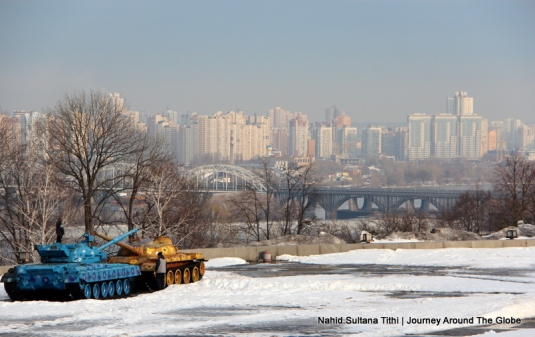
- Kiev skyscraper as seen from Motherland Statue
I didn’t want to be judgmental but my first impression of Ukrainians were that they were a bit unfriendly. But that thought changed as we interacted more with the locals. The locals are very helpful if they can properly communicate with you. Most of them barely speak English, but they try to help tourists as best as they can.
For transportation, Metro is probably the best way to get around. Look for the big green “M” sign for Metro stations. We paid only 2 UAH to enter the platforms to go anywhere. Some taxis go by meters, but with some, you may have to bargain. Another way to get around from upper town to the lower town near the river is the funicular. It costs 1.5 UAH per ride and the ticket station is behind St. Michael’s Church. Funicular is open from 7 am – 10 pm in weekdays and 8 am – 10 pm in weekends. It takes you down the small mountain and in Podil which is a hip area with many restaurants and shops.
TIME of TRAVEL: We flew to Kiev during Easter Break of 2013 at the very beginning of April. Temperature on the day we arrived and the next day were very low…either freezing or below freezing. But luckily, the last two days turned out to be a bit warmer and sunnier.
OUR HOTEL: We stayed in an apartment style hotel in the heart of Kiev, called “Khryschatyk Business Suites”. They have few different locations in the city center and ours was located right off of Independence Square. Along with a bedroom, a family room, nice bathroom, and a kitchen, we also had a great view of Independence Square right from our 6th floor apartment. There was no breakfast, but had free Wi-Fi.
EATING and SHOPPING: Other than pizza, shwarma, McDonald’s we had lunch in one fancy Ukrainian restaurant on our first day, name “Spotykach”. Borsch is a popular soup that I saw here and in couple other restaurants which is made from beet combined with some meat. We ordered some pumpushkin (Ukrainian breads) with the soup that came with 3 different types of yummy spreads. Also Ukrainian pancakes are very filling and good too, you can find these pancakes almost everywhere in Eastern Europe. I ordered my pancake with zucchini and sour cream…it was fantastic. Overall, food is very reasonable here compare to other European countries, I guess because they don’t use Euro here. You don’t have to empty your pocket to eat in a good restaurants in Kiev.
Since Ukraine was under Soviet Union once, many souvenirs have Russian influences, like Russian dolls and other trinkets. Russian dolls, known as “Matrioshka”, are very popular here. They can be cheap or expensive depending on the design and how many pieces they come with. The one we got had 10 pieces and we paid about 250 UAH. We saw many other traditional dolls in the stores too. Also colorful flowery wooden bowls and cutleries, jewelry boxes are beautiful to take back home. Scarves, embroidered tunics are almost everywhere too. There is also a big underground mall in Independence Square…very nice and has lots of brand name stores with a big food-court. Khryschatyk Street is a long stretch of shopping street that runs in the main city center near Independence Square. The street is very lively and crowded during weekends…a good place to just wander around.
PLACES WE’VE VISITED: The following places of Kiev we have visited were done in three days. Most of them we did it on foot while some were with metro.
1) INDEPENDENCE SQUARE or MAIDAN NEZALEZHNOSTI: Located on Khryschatyk Street, this is the main square and center of Kiev where you can spend hours roaming around. Independence Square is where Ukrainians met for protests many times in history. This is a beautiful and busy place to hang out day or night. “Monument in Honor of Independence of Ukraine” stands across the street on one end of this square and from the other end you can see green domes of St. Sophia’s Cathedral on Sofiyas’ka Street. Don’t forget to go to underground mall for good food and cool shopping.
2) ST. SOPHIA’S CATHEDRAL and MUSEUM: St. Sophia’s Cathedral is a beautiful center-piece in the City of Kiev. This is the oldest remaining church of the city and an UNESCO World Heritage Site. This 11th century architecture has been preserved almost intact. It was built by the Greeks and is an orthodox church.
Whole ground of this monastery is secluded with a boundary. Uniquely designed turquoise and white designed Bell Tower and the gilt copper entrance door to the cathedral are both from the 18th century. You can’t miss the sparkling multiple green domes when standing out in the square. The statue in the square where St. Sophia’s Cathedral stands is a statue of Bodhan, who was liberated Ukraine in the 17th century.
St. Sophia’s Cathedral has world’s BIGGEST ensemble of FRESCOES and mosaics from the 11th century revealing ancient exposed masonry. Some of old mosaic floors have been preserved in fragments. The present cast-iron floor slabs were laid in the 19th century. Some wall paintings from the 11th century, mosaics, and about 3000 sq. meters of fresco were preserved very mannerly and still can be seen inside the cathedral. Gorgeously decorated altar is the focal point and high dome with rich color frescoes are very eye-catching. We were told that builders used gold for all the mosaics here.
Metropolitan’s Residence of this cathedral is place, which is open to public now, was primary residence of the Father of the cathedral in the 18th century. You can see many decorative fireplaces and stoves here along with some old frescoes. It is considered as an outstanding and a historical monument of Ukraine. Refractory of St. Sophia’s Cathedral is another building in the monastery where you can see some old ruins, mosaic arts, and paintings. Nothing is written in English here but it’s a nice place to look around.
St. Sophia’s Cathedral is within walking distance from Independence Square and St. Michael’s Monastery. The museum and cathedral are open daily from 10 – 6 pm and 10 – 5 pm on Wednesdays. During winter, from November to April, it’s closed on Thursdays. Just to enter the territory, visitors must pay 3 UAH and 10 UAH extra to go top of the Bell Tower. General ticket, which includes admission to the territory, St. Sophia Cathedral, Refectory, and the Metropolitan’s Residence…the fee is 53 UAH for adults and 23 UAH for children. Visitors cannot take photos inside the cathedral; there are few green-robed ladies who sit in every corner of the cathedral and will shout if they see you clicking.
3) ST. MICHAEL’S GOLDEN-DOMED MONASTERY and STATUE of PRINCESS OLGA: This is a working monastery that dates back to the 12th century. The blue and white Bell-Tower from the early 18th century and the big mural before entering the monastery are eye-catching. Inside the church is very similar to St. Sophia’s Cathedral with striking and graceful mosaics. Exterior structure of the church is Ukrainian Baroque style while the interior kept its early Byzantine style. Colorful altar façade and frescoes of many saints are drop-dead gorgeous too. The place was destroyed by the Communists in the 1930s and was rebuilt in 1990s. Shiny golden domes add incredible beauty to the whole surroundings and to the monastery.
The monastery is located in Mikhailovska Square and can be seen from St. Sophia’s Cathedral. There is no entry fee to enter the monastery or the church inside. Tourists can take photos outside in the perimeter but not inside. Visitors can pay to climb the Bell Tower for a 360 view of the city.
Statue of Prince Olga dominates the big square, Mikhailovska Square, in front of St. Michael’s Golden-Domed Monastery. She was the FIRST known FEMALE RULER of the country. Behind the statue is Diplomatic Academy of Ukraine and on the right side is Foreign Ministry office near the square.
4) ANDREW’S DESCENT and ST. ANDREW’S CHURCH: Andrew’s Descent is a rough cobblestone street; at the one end of this winding road is Kontraktova Ploshcha in Podil and the other end, at the top of the hill is St. Andrew’s Church. There are many small shops, galleries, and souvenir sellers in Andrew’s Descent and near the church. Once on top of the hill, go up the stairs to enter the church. It’s a small church but very beautiful and richly decorated with red and golden colors. You can see River Dnieper and the city from up there. There is no fee to go inside.
We took funicular from behind St. Michael Cathedral down to Podil then walked to Kontraktova Ploshcha and up to St. Andrew’s Church. This was a bit tiring, may be better way to do this is walk down Andrew’s Descent to Podil then take funicular up to the upper town.
5) CHERNOBYL MUSEUM: I’ve heard of Chernobyl disaster when I was very young, so going to its museum was a must while visiting Ukraine. This is a very moving museum for adults and educational for kids. This nuclear plant disaster happened on April 26th, 1986 at 1:23 am due to faulty infrastructure and machine designs. As many as 76 communities near Chernobyl plant were destroyed and evacuated after the incident. Many are still suffering even after all these years of that catastrophic event. More than 7,000 items are on displayed in the museum. Museum has pictures of many rescuers, liquidators, and authorities who helped, suffered, and died due to heavy radiation burns or side effects. Tourists can also see some of their families and material belongings. The museum isn’t very graphic as far as after effects of the burst, like mutated human beings or animals…makes it very suitable for children.
A century old fire station houses Chernobyl Museum and it can be reached via Metro at “Kontraktova Ploshcha” and then few minutes of walk from there. It took us about little more than an hour (may take longer for some) inside the museum. It’s closed every Sunday and last Mondays of each month and open from 10 am – 6 pm all other days. Entry fee is 10 UAH for everyone including kids and we also had to pay 50 UAH to use our camera in the museum. Most of the information in the display are described in Ukrainian language…we couldn’t find anything in English. Therefore, I’d highly recommend it to rent English audio guide tour which gives a lot of background and detailed information on the museum and what actually happened in Chernobyl. There is a refundable 100 UAH fee for the audio guide.
6) MONUMENT to an UNKNOWN SOLDIER: #6 to #9 are all in one area and can be done together. We got off at Metro station “Arsenalna” and started walking towards Pechersk Lavra and saw these places along the way. This is the hilly part of Kiev, therefore you get a view of the lower city from this part. A big park before arriving to Lavra has few memorials and is decorated with many beautiful statues where we saw #6 and #7.
Monument to an Unknown Soldier was our first stop after getting out from the metro. The tall obelisk stands in the middle of an open park. Walk around the monument and you will get a nice view of River Dnieper from above.
7) MEMORIAL for FAMINE VICTIMS in UKRAINE: During Soviet Union reign Ukrainian people suffered horrible tragedy/famines which took millions of Ukrainian lives. The WORST humanitarian CATASTROPHE of 20th century for Ukraine was man-made Famine of 1932 – 1933 (artificially engineered by Stalin’s regime), during which few millions of people died. A white, black, and gold memorial with a statue of a little starving girl in the front was built for all those victims. Walk pass the Monument to an Unknown Soldier and walk towards Lavra…you can’t miss it.
8) PECHERSK LAVRA (CAVE MONASTERY): This is one of the oldest and most important monasteries in Ukraine and former Soviet Union. It was founded in 1077. The caves in lower Lavra were dug out by the priests who lived there as hermits. Nowadays, tourists can visit these caves for free if properly dressed…but they were closed during our visit, so we missed it. This is an UNESCO World Heritage Site and definitely a must see in Kiev.
The monastery is still active and surrounded by many small old neighborhoods. This is a big compound and within the territory of Lavra you can see many golden domes and steeples shinning at every corner…some are of small chapels and some are big. We visited a small chapel of the main church near the grand Bell Tower since the main one was not accessible at that time. Many exhibitions were going on in different buildings of Lavra which are free to enter once you are inside the compound.
Metro station “Arsenalna” is only few blocks away from the monastery. Opening hours are 9 – 6 pm in winter and 8 – 8 pm in summer. They are closed on Tuesdays. We paid 50 UAH per person (kids free) to enter the perimeter. It’s not strictly maintained, but visitors are not supposed to take any pictures inside any chapel…outside is ok.
9) MOTHERLAND STATUE and GREAT PATRIOTIC WAR MEMORIAL: This is not a typical war memorial. It’s is a big open park within walking distance from Lavra with many war statues and couple of museums. Walking towards the focal point of this complex which is “Motherland Statue” we passed few small memorials, statues, a museum that features all the vehicles and tanks that were used in WWII. Gigantic silver “Motherland Statue” is a lady looking over Kiev and River Dnieper with a sword in one hand and a shield on the other. The Museum of the Great Patriotic War (WWII) is located at the base of the statue. The museum was already closed by the time we went there but it’s a must if you are interested in German-Soviet war in WWII. The whole complex was built in memory of WWII from 1941 – 1945. You won’t miss the massive sculpture of many soldiers representing combats of German-Soviet war. Walk around areas surrounding the museum and the statue, especially under the bridge for many groups of statues depicting some touching pictures of WWII. You can see many examples of classic Soviet-era war pictures. This is also probably one of the best places to get a good view of Kiev skyscrapers and the river.
This is a big open park, great for walking, strolling, and enjoying Kiev from top. Metro station “Arsenalna” is the closest station from here. But if you are already near Pechersk Lavra, it’s about 10 – 15 minutes’ walk from there.
10) GOLDEN GATE of KIEV: This is very close to St. Sophia’s Cathedral and in Metro station “Zoloti Vorota”. Honestly, I wasn’t too impressed with the exterior of the building…it’s a big square-shaped building. We didn’t go inside but the statue in one side of the building was nice.
11) BABYN YAR: This was a site where German NAZI armies MASSACARED Jewish, Gypsies, and many others during WWII. As many as 60,000 VICTIMS were executed in and near a big ravine. The surrounding area of 1 or 2 km was used to commit the mass murders. Now it’s an open park with many trees and a pathway. A big memorial to “Soviet Citizens” stands in one side of the ravine. There isn’t much to do here but the place does make you feel sad. The park can be reached via Metro station “Dorohozhychi”.
Related articles
- 1st day in Kiev, Ukraine (journeyaroundtheglobe.com)
- Kiev – Ukraine (via Transnistria apparently!) (aroundtheworldin40years.wordpress.com)
- Course: Bridge Education Abroad Institute, Kiev, Ukraine (thenewirscholar.wordpress.com)
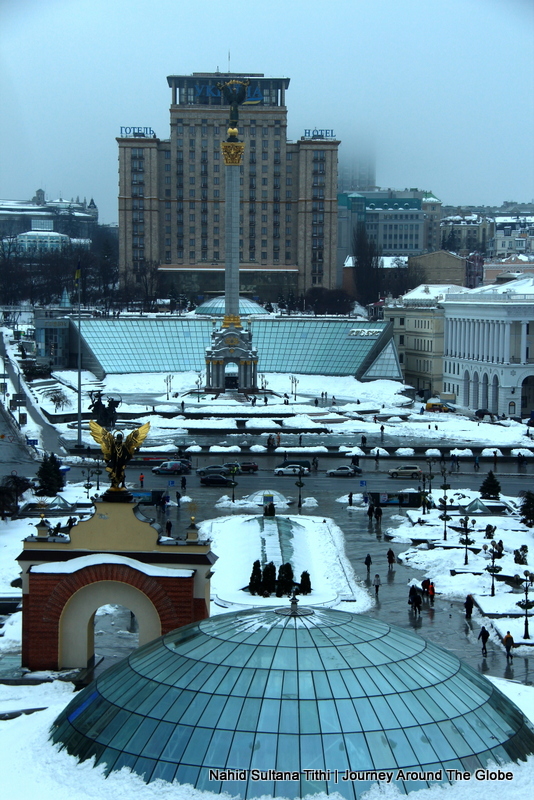

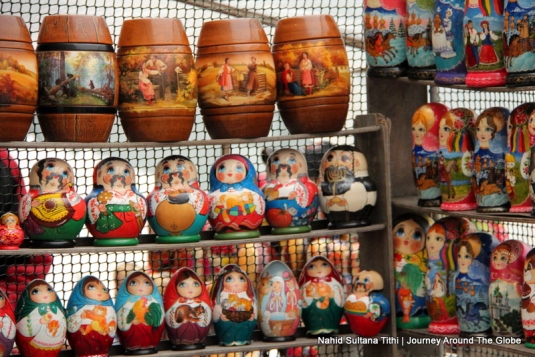

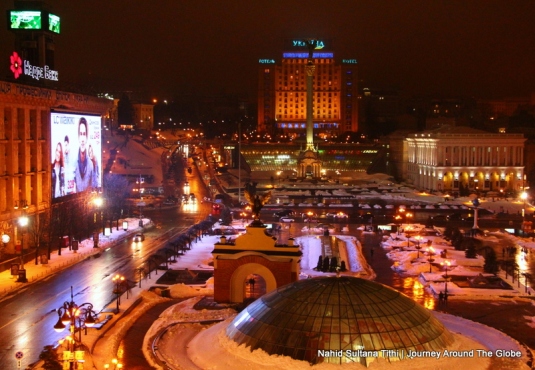
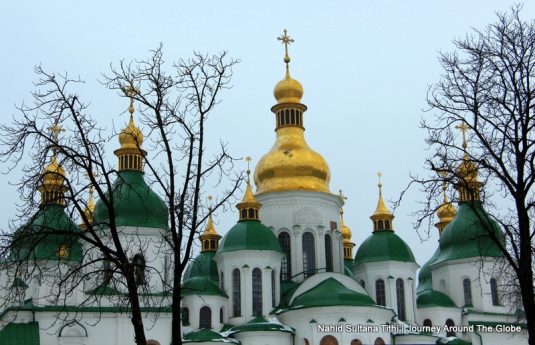
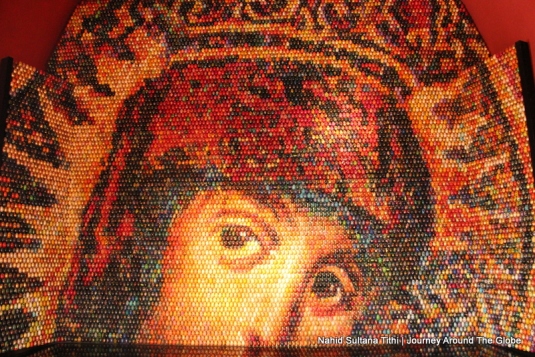

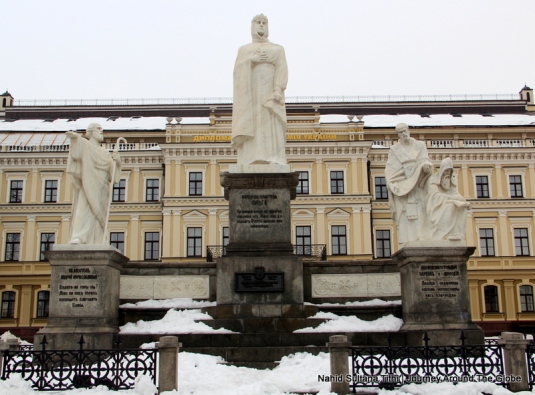
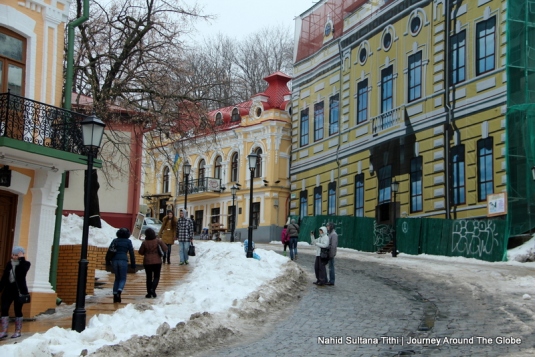
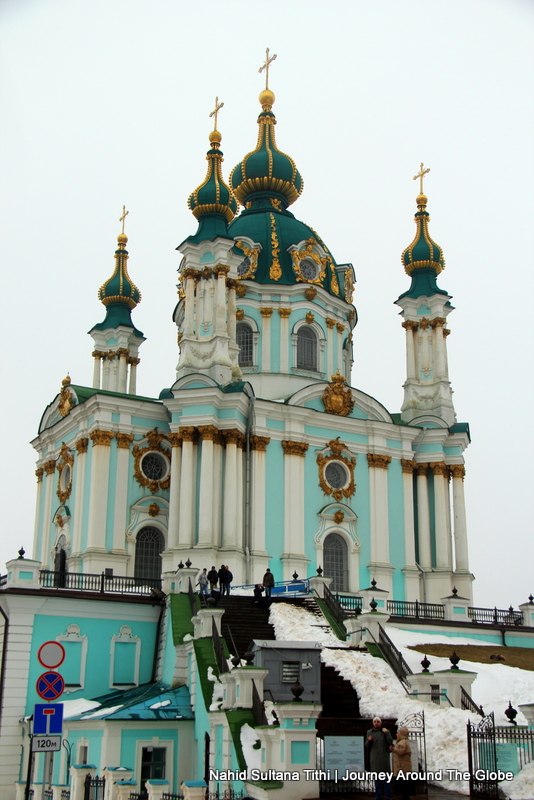
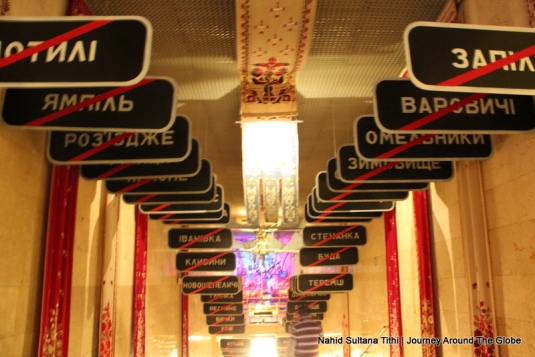
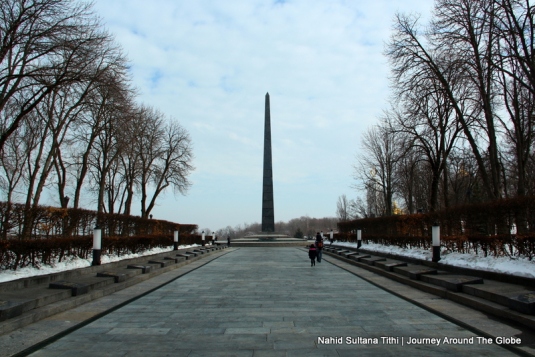
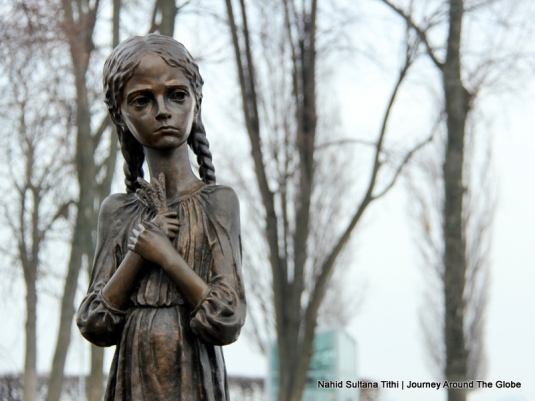
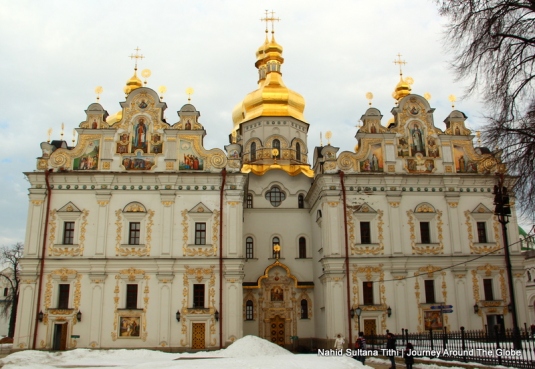
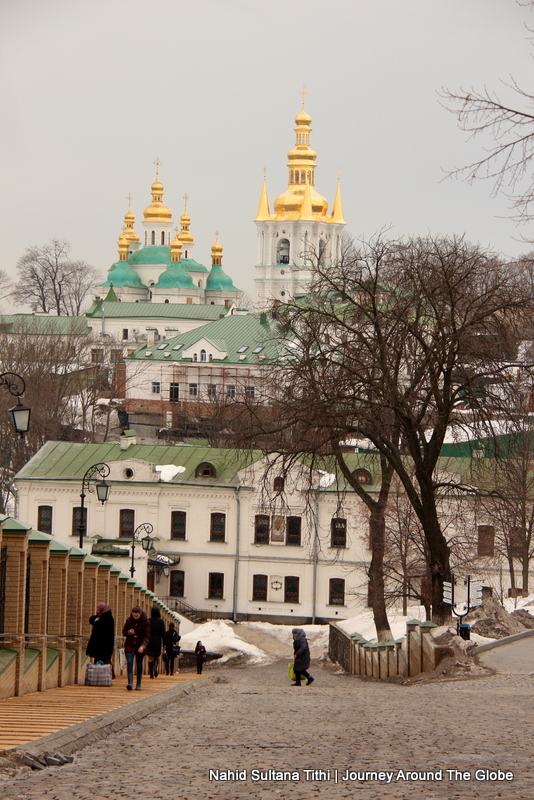
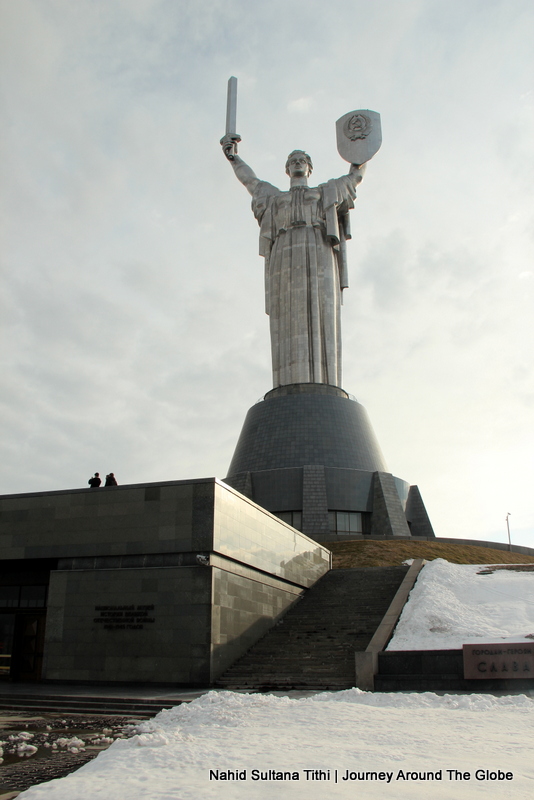
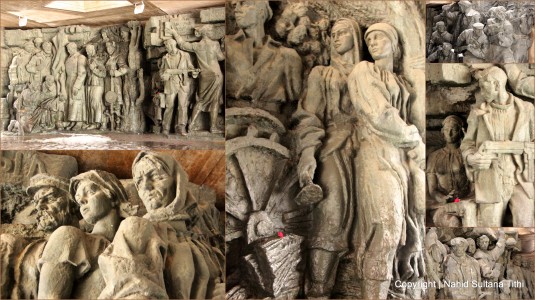
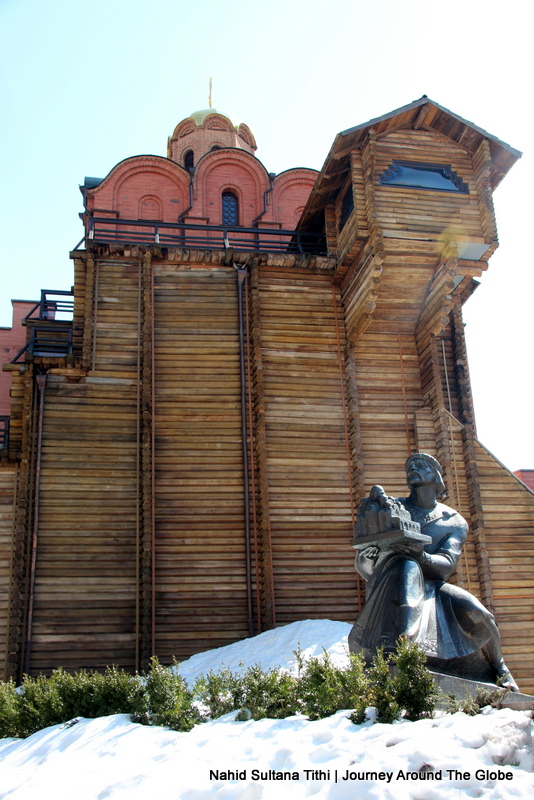
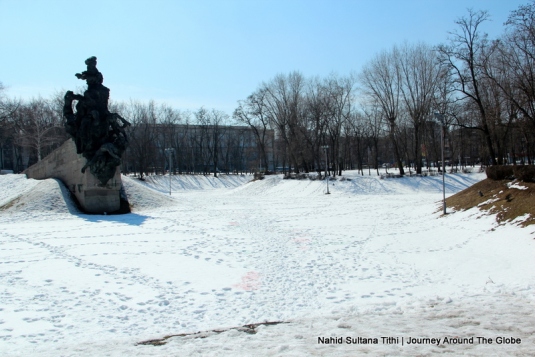




I’m just stunned. What a fascinating place. Such beauty and sadness. Well written. Maybe you could tell us in one of your posts, why you chose to visit here? Cheryl
LikeLike
It was my husband’s idea to visit Kiev and Sofia during Easter Break…he likes going to places where usually people don’t go. Thanks for your nice words…cheers
LikeLike
What a beautiful, historic country with many magnificent churches. But the statue of the starving little girl tugged at my heart.
LikeLike
Eastern Europe is beautiful all together, especially former Soviet Union countries…they have some unique looking churches…thanks for stopping by Bev
LikeLike
Love Kiev! Great synopsis on cool stuff to do there. I just shared this with a friend who is going there.
LikeLike
Wow, thanks for sharing and stopping by…cheers
LikeLike